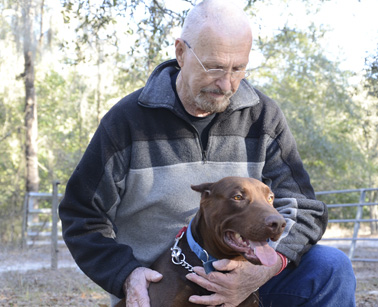
CARL MCKINNEY/ Alachua County Today
The Rev. George Trotman begins his speech at the MLK celebration. He read the famous "I Have a Dream" speech in its entirety.
ALACHUA – A city gathered to celebrate one of the 20th Century’s most famous civil rights activists.
The City of Alachua held its celebration of Martin Luther King Jr. for the ninth year in a row on Monday, Jan. 20 at the Hathcock Community Center.
The ceremony started around 11 a.m., with Wilma Rogers, who helps run the Alachua Music and Arts Program, giving a speech on the changes King brought about.
“That change lives on inside each of you,” she said. Positive change is rewarded by God, she added.
After Mayor Gib Coerper acknowledged the veterans in the audience for their service, City Manager Traci Cain gave her interpretation of the celebration.
“What a beautiful day it is to come together as neighbors, friends and family,” she said.
Cain talked about the sacrifices King made for civil rights.
“He put his life on the line for what he believed,” she said. She spoke of the hope he had.
“Let’s continue to have hope.”
Rogers then brought the children of the Music and Arts Program on to the stage to sing “We Can Change the World,” composed by Wilma Rogers’ husband, Bill Rogers. Samantha Flores, one of the young singers, led the performance.
The group recently had a chance to visit Martin Luther King Jr.’s home in Alabama. They have also been invited to attend the Trumpet Awards in Atlanta, Ga. at the end of the month to represent Alachua. The show will be televised in 185 countries.
Joni Perkins, from the Music and Arts Program, recited the Maya Angelou poem “Still I Rise,” which challenges everyone to hold their head high and empower themselves and others.
Wilma Rogers took the stage again, this time to thank the parents for their support of the Music and Arts Program.
“We cannot do this without you,” she said.
The Rev. George Trotman then took the stage as the main speaker, talking about the lasting impact of Martin Luther King Jr.
“Truly, this is a good day,” he said. “We are blessed to be in a land where we can assemble together.”
If Martin Luther King Jr. was still alive, Trotman said, he would say all honor and praise should go to God, not himself.
“We thank God for Martin,” he said. “The one prevailing thought was his love for humanity.”
Trotman recited the entirety of King’s famous “I Have a Dream” speech.
As Rogers closed the ceremony, she invited the audience to remember, celebrate and act. She challenged everyone to follow through on their dreams. She also asked people to share an appreciation for history with the youth, something she said many young people lack.
For the rest of the afternoon, residents ate barbecued meat, listened to musicians strum guitars and conversed with one another.
# # #
Email cmckinney@
alachuatoday.com
Add a comment


